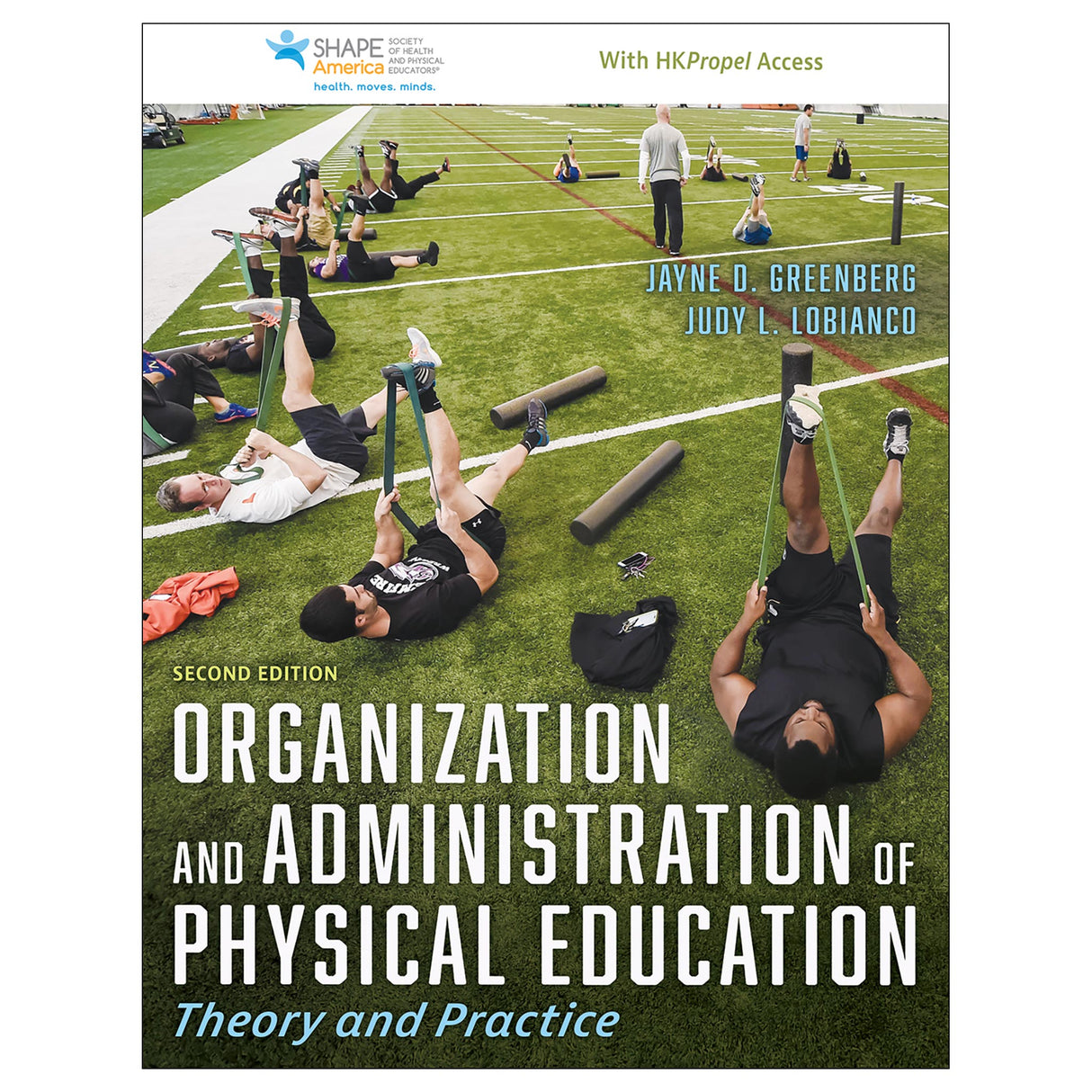Organization and Administration of Physical Education 2nd Edition Ebook With HKPropel Access
Theory and Practice
Author: Jayne D. Greenberg, Judy L. LoBianco
$114.95 CAD

This edition is thoroughly updated by two award-winning educators, Jayne Greenberg and Judy LoBianco, who are joined by a sterling list of contributors who have taught at every education level in urban, suburban, and rural settings.
In this second edition, the roles and responsibilities of PE administrators are examined through theoretical and practical lenses. Beyond incorporating the revised PE standards and the latest research throughout, other enhancements to this edition include the following:
- An expanded technology chapter that addresses equity and the digital divide, remote learning, virtual and augmented reality, and artificial intelligence
- A more comprehensive chapter on teacher and program evaluation
- A new chapter on social-emotional learning (SEL) with connections between content, pedagogy, and practices
- A new chapter on diversity, equity, and inclusion that provides culturally responsive teaching approaches to elevate the participation of underrepresented teachers and students
- New content for physical education department chairpersons
Part I explores leadership and management styles and presents practical theories of motivation, development, and planning for the essential components of a quality PE program.
In part II, readers examine various curriculum, instruction, and assessment models and get guidance on planning special events.
Part III helps administrators plan new school facilities or renovate existing ones, and it presents contemporary concepts in universal design and sustainable environmental design. It also offers ideas on how to incorporate technology, including developing online PE courses.
Part IV explores communication, legal issues, and human resources so administrators can learn how to advocate for their programs.
Part V explains the fiscal responsibilities inherent in administrative positions and shows how administrators can secure independent funding, offering many examples of grants and fundraising opportunities with sample grant applications.
Part VI, new to this edition, explores the integration of content and pedagogy with SEL practices. It also offers legal and practical strategies to enhance the involvement of those who are underrepresented in PE.
Each chapter also includes sidebars from professionals, who share tips and insights on successful program implementations. To further enhance practical application, readers have online access to downloadable forms, checklists, and other supportive materials.
Published with SHAPE America, this text offers the solid foundational theory and practices needed for today’s challenges in PE administration.
Note: A code for accessing HKPropel is included with this ebook.
Audience
Textbook for upper-level undergraduate and graduate courses on the organization and administration of physical education. Reference for physical education administrators.Chapter 1. The Role of a Physical Education Administrator as a Leader
Jayne D. Greenberg
Roles and Responsibilities of the Physical Education Administrator
Leadership Versus Management
Leadership Defined
Characteristics of Effective Leaders
Developing Leaders
Understanding Your Philosophy of Leadership
Determining Your Leadership Style
Theoretical Approaches to Leadership
Power, Authority, and Influence
Motivation Theories of Leadership
Strategic Planning
Ethical Leadership
Conflict Resolution
Diversity in Leadership
Conclusion
Chapter 2. Management and Operations
Jayne D. Greenberg
Management Theories
Management Skills and Competencies
Roles and Responsibilities and Administrative Functions
Change Theory
Day-to-Day Operations
Teachers as Leaders
Conclusion
Chapter 3. Organizing and Planning a Quality Physical Education Program
Jayne D. Greenberg
Definition of Physical Education
Benefits of a Quality Physical Education Program
Program Planning
Essential Components of Physical Education
Program Planning Considerations
The School and Community Connections National Framework: Comprehensive School Physical Activity Plan
The Whole School, Whole Community, Whole Child Model
Conclusion
Part II. Curriculum, Instruction, Assessment, and Special Events
Chapter 4. Curriculum Development and Evaluation
Nichole D. Barta and Jayne D. Greenberg
The Curriculum Development Process
Understanding Standards-Based Curriculum Development
The Analysis Phase
The Planning Phase
The Design Phase
The Implementation Phase
The Evaluation Phase
Conclusion
Chapter 5. Quality Instruction
Nichole D. Barta and Jayne D. Greenberg
Appropriate Instruction
Factors That Influence Quality Instruction and Environment
Conclusion
Chapter 6. Teacher and Program Evaluation
Erin E. Centeio, Heather E. Erwin, and Jayne D. Greenberg
Teacher Evaluation Models
Perception of Evaluation
Developing a Growth Mindset and Considerations for Evaluation
Components of Teacher Evaluation
Teacher Observation
Program Evaluation
Conclusion
Chapter 7. Event Planning, Special Programs, and Field Trips
Jayne D. Greenberg
Conducting Community-Wide Events
Field Trips
Conducting School-Wide Events
Before- and After-School Programs
Conclusion
Part III. Facilities, Equipment, and Technology
Chapter 8. Facilities, Design Criteria, and Equipment
Jayne D. Greenberg
Defining the Purpose of a Facility
Construction of a New Facility
Planning Facilities
Role of the Planning Committee
Design Standards, Universal Design, and Sustainable Design
General Considerations for Physical Education Construction Projects
Indoor Facilities
Wellness or Fitness Centers and Weight Training Rooms
Outdoor Facilities
Physical Education Preferred Equipment
Shared Facilities
Conclusion
Chapter 9. Technology in Physical Education
David N. Daum, Tyler Goad, and Jayne D. Greenberg
Why Use Technology in Education?
Technology Frameworks
Understanding Teachers and Students
Technology in Physical Education
Inappropriate Uses of Technology in Physical Education
Planning for Technology Integration
Understanding the 21st-Century Learner
Technology for Instructional Use
Innovative Uses of Technology
Teaching With Learning Management Systems (LMSs)
Online Physical Education (OLPE)
Keeping Up With Technology
Continuing Professional Development
Conclusion
Part IV. Communication, Legal Issues, and Human Resources
Chapter 10. Communications, Internal and External Public Relations, and Advocacy
Jayne D. Greenberg and Carly Wright
Effective Communication
Direction and Flow of Organizational Communication
Elements of Effective Communication
Methods of Communication
Public Relations
Advocacy
Conclusion
Chapter 11. Legal Issues and Loss Prevention in Physical Education
John O. Spengler and Jayne D. Greenberg
Constitutional Law
Liability in Physical Education
Loss Prevention in Physical Education
Bullying, Harassment, and Sexual Harassment
Gender Issues
Conclusion
Chapter 12. Human Capital Management
Lauren O’Mara and Jayne D. Greenberg
Recruiting Talent
Onboarding and Orientation
Induction, Training, and Mentoring for Teacher Retention
Professional Development
Performance Management
Working With Labor Unions
Conclusion
Part V. Financial Management
Chapter 13. Fiscal Management
Jayne D. Greenberg
Understanding District Budgets
The Budget Process
Expenditure of Funds: Purchasing Process
Working With Vendors
Bid Process
Audits
Travel and Meal Reimbursement
Conclusion
Chapter 14. Grant Writing and Outside Funding
Jayne D. Greenberg
Securing Local Funding: Dipping Into Discretionary Accounts
Securing and Developing Business Partnerships
Corporate Donations and Sponsorship
Fundraising
Securing Funding Through Grants
Conclusion
Part VI. Meeting Social Issues and Challenges
Chapter 15. Social Emotional Learning and Physical Education Content, Pedagogy, and Practices
Cara D. Grant
History of Social and Emotional Learning (SEL)
Defining Social and Emotional Learning (SEL)
CASEL SEL Framework Overview
SEL, Adverse Childhood Experiences (ACEs), and Trauma
Connecting SEL and Physical Education
Model-Based Practices in Physical Education
Sample SEL Educational Programs
SEL and Justice, Equity, Diversity, and Inclusion (JEDI)
SEL Equity Elaborations
Successes in Implementing SEL Programming
Conclusion
Chapter 16. Diversity, Equity, and Inclusion: Underrepresented Teachers and Students in Physical Education
Wesley J. Wilson and Mara Simon
Disability in Physical Education
Race in Physical Education
Gender in Physical Education
Sexuality in Physical Education
Low Socioeconomic Status in Physical Education
Conclusion
Identifying gender issues and pursuing gender equity in physical education
What’s the role of the National PE Standards in program planning?




All ancillaries are free to adopting instructors through HKPropel.
Instructor guide. Includes a syllabus, answers to the chapter review questions from the book, suggested readings, and tips for presenting important key concepts.
Test package. Contains over 300 questions in multiple-choice format. The files may be downloaded for integration with a learning management system or printed for use as paper-based tests. Instructors may also create their own customized quizzes or tests from the test bank questions.
Presentation package. Features more than 350 PowerPoint slides of text, artwork, and tables from the book that can be used for class discussion and presentation. The slides in the presentation package can be used directly within PowerPoint or printed to make handouts for students. Instructors can easily add, modify, and rearrange the order of the slides.
Instructors also receive access to all student materials in HKPropel. For Organization and Administration of Physical Education, Second Edition, this includes downloadable PDFs of tables and figures from the book as well as forms, checklists, and other materials that can be used by a PE administrator.
Human Kinetics is pleased to partner with SHAPE America by offering discounts on our resources to SHAPE America members! Whether you’re a preK-12 teacher, higher education faculty member, researcher, administrator, or future professional, we’re here to help you in your professional career and personal fitness journey of improved fitness, stronger athletic performance, and better nutrition.
SHAPE America members receive a 30% discount on this resource and other eligible resources through the member portal at SHAPE America. Learn more about SHAPE America membership at SHAPEAmerica.org or direct your questions about the discount to askmembership@shapeamerica.org.





